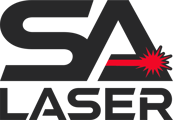Understanding and Managing Shape Connectivity for Laser Design
Shapes in LightBurn are made up of lines, curves, and nodes. Whether a shape is open or closed affects how it interacts with various tools and laser operations. Understanding these differences is key to successful laser design and execution.
What Are Open and Closed Shapes?
- Closed Shapes: A continuous loop where the start and end points connect. These are required for many functions that involve identifying "inside" and "outside" areas, such as Fill Mode.
- Open Shapes: A shape where the start and end points do not connect. LightBurn interprets these as line segments, with no defined inside or outside.
To view a shape’s nodes:
- Select the shape.
- Enable the Edit Nodes tool.
- Start and end nodes appear larger and green.

Why Shapes Must Be Closed
Certain functions in LightBurn require closed shapes because they rely on distinguishing between inside and outside areas. Key operations that need closed shapes include:
- Fill Mode: Engraving areas within a shape’s boundaries.
- Offset Fill Mode: Similar to Fill Mode but optimized for hollow designs.
- Weld: Combining overlapping shapes into a single outline.
- Boolean Tools: Operations like union or subtraction between shapes.
- Cut Shapes: Splitting a shape into parts.
- Kerf Offset: Adjusting for material loss during cutting.
- Cut Inner Shapes First: Prioritizing inner shapes before outer shapes.

Identifying Open Shapes
Some open shapes are obvious, like line segments, but others may have small or invisible gaps. LightBurn offers several methods to identify these:
1. Edit Nodes Tool
- Highlight the start and end nodes to determine if they connect.
- Zoom in to spot gaps if nodes overlap but do not connect.

2. Measure Tool
- Select the Measure Tool (Alt/Option+M).
- Hover over a segment to see a descriptor indicating if the shape is open or closed.

3. Warning Messages
- If open shapes are assigned to Fill or Offset Fill layers, LightBurn warns you when previewing or starting a job.
- Options include:
- Continue: Remove open shapes from the job.
- Show Me: Automatically select the open shapes.

4. Select Open Shapes
- Go to Edit Menu → Select Open Shapes to highlight all open shapes in the workspace.
- Use Select Open Shapes Set to Fill to find open shapes assigned to Fill or Offset Fill layers.

Correcting Open Shapes
Before closing an open shape, consider whether it’s necessary. For example, open shapes often work best in Line Mode for scoring or marking. If closure is required, LightBurn provides several tools:
1. Edit Nodes Tool
- Drag a start node onto an end node to manually close a shape.
2. Close Path
- Found in the Edit Menu.
- Connects start and end nodes within 0.5 mm by creating a new line.
3. Close Selected Paths with Tolerance
- Found in the Edit Menu.
- Specify a Distance Threshold to close gaps.
- Options:
- Move Ends Together: Adjust existing lines to connect.
- Join with Line: Create a new segment between nodes.

4. Auto-Join Selected Shapes
- Shortcut: Alt/Option+J.
- Joins multiple disconnected segments if nodes are within 0.05 mm.
- If it fails, use Break Apart (Alt/Option+B) and try again.
Best Practices for Managing Shapes
- Use the Preview Window: Check your design’s output before starting a job to confirm shapes behave as intended.
- Assign Layers Appropriately: Open shapes work well with Line Mode, while closed shapes are needed for Fill or Offset Fill layers.
- Zoom in for Precision: Small gaps may require close inspection to identify and correct.
By understanding the distinctions between open and closed shapes and leveraging LightBurn’s tools, you can ensure your laser projects are precise and efficient.

